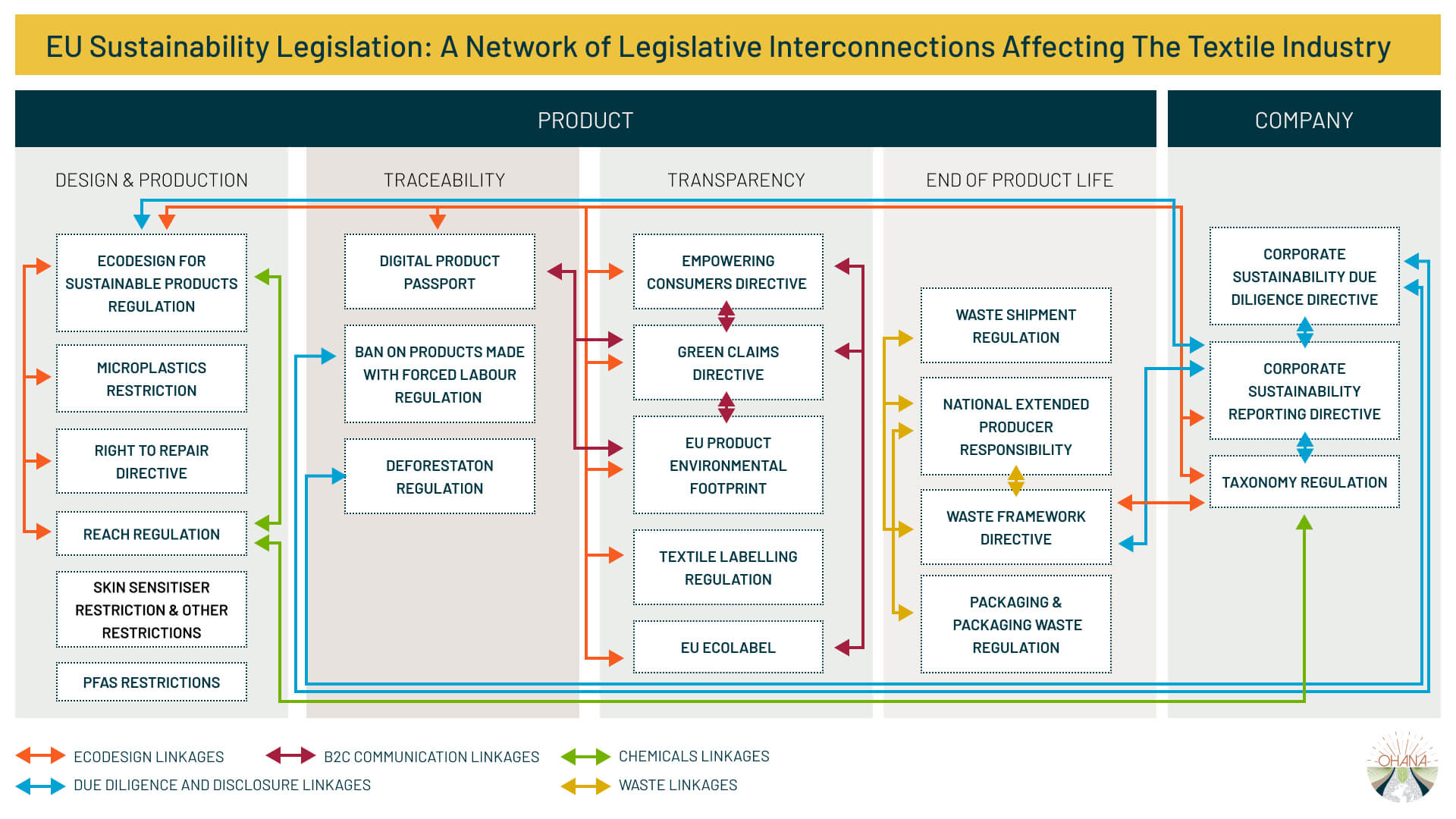
Textiles & EU Sustainability Law: A Recap of EU’s Current Mandate Before 2024 Election
The 2024 EU elections are upon us, making this a strategic moment to reflect on the current mandate’s accomplishments and to discuss what’s on the horizon.
In this special recap piece, we wanted to offer a reflection of the main events surrounding sustainability legislation for textiles between 2019 and 2024. And with the help of the entire Ohana team, we have also included an array of insightful comments and analyses from our experts, which will help you understand and prepare for what’s coming over these next five years. So let’s dive right in!
“The recent mandate has been transformative for sustainability, showcasing a commendable effort by both the EU Commission and Parliament in driving meaningful and lasting change. The alignment between these institutions was pivotal in achieving this progress.
One of the standout successes is the regulation of the textile industry on sustainability matters, marking a significant achievement. While substantial strides have been made in areas such as climate, circularity, traceability, and transparency, there remains much work to be done to fully realise our sustainability goals.”
— Pascale Moreau, Founder and Managing Director.
Want someone with deep experience and connections in the EU to help guide your sustainability strategy? Get in touch!
The EU Green Deal: A Foundation for Sustainability
There’s no talking about the 2019-2024 mandate without discussing the EU’s flagship sustainability initiative, the European Green Deal (EGD), designed to make the Union climate-neutral by 2050. Launched in December 2019, it’s an overarching strategy to create a sustainable and circular economy, reduce carbon emissions, boost resource efficiency, and support environmental biodiversity. Encompassing a wide range of policies and legislative measures across various sectors including energy, transport, agriculture, and manufacturing, the Green Deal is considered the key to decoupling the block’s economic growth from resource use and environmental impact.
Even if we focus on the textile sector alone, the number of sustainability policies currently affecting the industry is so significant that we prepared the infographic below to help clarify how they connect to each other. In the following sections, we will also explore the details of most of these legislative pieces and their role in the EU’s sustainability agenda.

Key Initiatives Focused on Design, Production & Circularity
Product design is a critical part of making sustainable products easily accessible for consumers, and ambitious policies such as the Eco-design for Sustainable Products Regulation (ESPR) are empowering the EU to establish and regulate strict environmental standards when it comes to a whole range of products.
The current mandate has placed significant emphasis on making circular business models the norm within the Union, and the introduction of the EU Circular Economy Action Plan created a crucial foundation for realising that goal.
“This move towards a circular economy is urgently needed if we are to reach our climate and sustainability targets, and transition into a society with truly sustainable practices.”
— Rannveig van Iterson, Head of Circularity at Ohana
“The European Union’s actions in the previous mandate set a global precedent as leaders committed to the planet and society. Progress toward a circular economy has inspired hope for the future. To achieve our climate and sustainability goals and transition to genuinely sustainable practices, this progress must continue as the foundation for the next mandate.”
— Analoli del Cueto Menéndez, Junior Public Affairs Consultant
From the waste perspective, the focus has not only been placed on reducing waste generation, but also treating waste as a resource, and ceasing its export to third countries. Among other initiatives, this has been ensured through the revision of the Waste Shipment Regulation (WSR) and the Waste Framework Directive (WFD).
Let’s take a deeper look at a summary of the key policies focused on design, production and circularity within the 2019-2024 mandate.
EU Waste Shipment Regulation (WSR)
The revised Waste Shipment Regulation aims to strengthen controls on the export of waste, including textile waste, to ensure it is managed in an environmentally sound manner. The updated rules include a prohibition on the export of textile waste to non-OECD countries for recovery, with certain exceptions, and the disposal of waste in landfills is now prohibited. Preventing the export of these loads to third countries with insufficient waste management infrastructure, the WSR should work to strengthen the growing recycling networks within the EU.
“The WSR is set to come into effect between 2026 and 2027, and is still awaiting the publication of secondary legislation by the EU Commission. Therefore, there is still a lot of work ahead of the industry to analyse and implement the upcoming requirements.”
— Karina Grucka, Public Affairs Consultant at Ohana
EU Waste Framework Directive (WFD)
The targeted amendment proposed by the European Commission to the Waste Framework Directive was created with a particular focus on the food and textiles sectors. The original 2008 WFD directive mandates the implementation of separate collection of textile waste in all Member States by 1st January 2025, and therefore, the recent targeted revision introduces mandatory Extended Producer Responsibility (EPR) schemes that will demand each EU nation to develop the necessary infrastructure.This system will help the Member States to set up the infrastructures based on the EPR fees, which will be paid by the producer following the polluter pays principle. However, we regret that the targeted revision of the current WFD came so late. The aim of the proposal is to accelerate a separate collection, sorting, reuse and recycling sector for textiles in the EU, however the transposition of the WFD will happen only in 2027.
“I welcomed the European Commission’s decision to revise the Waste Framework Directive, however, it is regrettable that this amendment was introduced so late in their mandate. Had the Commission initiated this revision earlier, Member States might have been adequately prepared to meet the separate collection obligations on time, ensuring a smoother transition and more immediate impact on textile waste management by the 2025 deadline.”
— Karina Grucka, Public Affairs Consultant at Ohana
EU Eco-design for Sustainable Products Regulation
The Eco-design for Sustainable Products Regulation (ESPR) aims to make sustainable products the norm within the EU market by setting robust design requirements for textiles and other products. This regulation focuses on improving the durability, repairability, and recyclability of products, but also on reducing their environmental impact by ensuring energy and resource-efficiency.
“As the specific eco-design measures for apparel and textiles are yet to be developed and only expected in a few years, it’s too early to say what exact impacts they will have on the industry. However, we can certainly see that the mere promise of dedicated standards for textile product design gears up the industry to start preparing and improving their practices. This is very promising.”
— Rannveig van Iterson, Head of Circularity at Ohana
Delayed EU REACH Regulation Revision
The anticipated revision of the REACH regulation has been further delayed. Originally the revision aims to ensure that products are safe for consumers and the environment by restricting or banning harmful chemicals. The foreseen revision is now scheduled for the next political mandate. This delay is part of a disappointing development which started in 2023, where we have seen a major departure from the European Green Deal ideals.
“Crucial regulations and revisions, such as the Nature Restoration Regulation and the revision of REACH Regulation were watered down or risk being withdrawn. The future objectives will depend on the results of the EU elections. I am unsure if the institutions will propose measures responding sufficiently to the environmental crisis.”
— Jędrzej Nadolny, Public Affairs Consultant at Ohana
EU Microplastics Regulation
The proposed EU Microplastics Regulation aims to reduce microplastics pollution, protecting human health as well as the environment on a global scale. Originally intended to also cover microplastics release from textiles, the legislation’s scope has been narrowed to focus specifically on regulating plastic pellet releases. The issue of microplastics from textiles will now be addressed under the Eco-design Regulation for Sustainable Products, with details to be revealed in the upcoming ESPR delegated acts.
EU Right to Repair Directive
The Right to Repair Directive proposal introduces a right to repair for products that are technically repairable under EU law. This initiative aims to foster affordable repair options for consumers, even beyond the legal guarantee period, promoting sustainable consumption, combating waste, and supporting the repair industry.
Adopted by the European Commission in March 2024, it is expected to be implemented between late 2026 and early 2027, encouraging consumers to repair rather than replace products, including clothes and other textiles.
EU Packaging & Packaging Waste Regulation (PPWR)
The revised Packaging and Packaging Waste Regulation, sets ambitious targets for reducing packaging waste and promoting recyclable and reusable packaging solutions. For the producers placing packaging on the EU market, this means minimising the environmental impact of packaging materials and improving packaging design. Recently approved by Parliament, the PPWR will most likely enter into force by Q4 2024, and starts applying 18 months from that entry into force date, likely in mid 2026.
Policies Targeting Traceability, Transparency & Responsible Business Conduct Across Supply Chains
A number of ambitious legislative pieces have been introduced as part of the Green Deal to make European companies and global supply chains environmentally and socially sustainable. These include the regulations combating forced labour and deforestation and the overarching initiatives tackling various negative impacts on people and the planet, such as the Corporate Sustainability Due Diligence Directive (CS3D) and Corporate Sustainability Reporting Directive (CSRD). Big strides have also been made on transparency and disclosure, with the introduction of the streamlined corporate sustainability reporting under CSRD and the EU taxonomy.
“Traceability has become a key element of multiple legislations on sustainable value chains, such as the Deforestation Regulation and the EU Forced Labour Ban, and potentially in the future, in the Digital Product Passport under the ESPR.The traceability requirement in combination with due diligence duty will trigger big transformations in supply chains giving visibility to where and how the products have been produced and with what effect to the planet and the people.”
— Natalia Yerashevich, Head of Transparency & Supply Chain at Ohana
Plus, multiple other policies have raised the bar for how businesses can communicate with consumers about sustainability. Among other initiatives, the growing concern around greenwashing brought about the EU Green Claims Directive (GCD), and the EU is now set to ensure that consumers are only exposed to voluntary sustainability communication based on verified data.
“With the revision of transparency policies, the EU gave companies a strong message that they must think seriously about the robustness of their sustainability claims. Still, the EU has to ensure that data verification requirements are robust but not too burdensome for companies to prevent green-hushing.”
— Jędrzej Nadolny, Public Affairs Consultant at Ohana
As we continue our recap, let’s place our attention on some of the main sustainability initiatives from these past 5 years related to traceability, transparency and producer responsibility.
EU Deforestation Regulation
The EU Deforestation Regulation addresses the import of seven commodities (cattle, cocoa, coffee, oil palm, rubber, soya and wood) and associated products linked to deforestation and forest degradation. For the textiles sector, this means ensuring that raw materials such as leather, fur and rubber are sourced sustainably and do not contribute to deforestation. This regulation mandates a range of due diligence and traceability requirements for companies, with core obligations becoming applicable from 31st December 2024.
EU Corporate Sustainability Reporting Directive
Aiming to provide investors and consumers with reliable sustainability information, the Corporate Sustainability Reporting Directive, significantly expands the scope and detail of the previous sustainability reporting required from large companies. Under the CSRD, companies must disclose information on their environmental, social, and governance impacts, including data on carbon emissions, resource usage, and supply chain practices.
Empowering Consumers to Green Transition Directive
As one of the initiatives that make up the EU’s Communications Framework, the Empowering Consumers to Green Transition Directive (ECGT) aims to empower consumers by obliging companies to provide trustworthy and easily accessible information about their products including textiles and garments. The Directive revises criteria on what constitutes a misleading voluntary claim. It also includes new requirements for certification schemes. By enabling consumers to make informed choices, this directive supports the transition to a green economy.
EU Green Claims Directive
Complementing the Empowering Consumers Directive, the Green Claims Directive focuses specifically on eradicating misleading voluntary claims related to sustainability and environmental matters, also known as greenwashing. The Directive seeks to enhance consumer trust and support genuine sustainability efforts by ensuring that all environmental claims are accurate and substantiated. It sets requirements for a pre-approval of claims.
EU Corporate Sustainability Due Diligence Directive
The Corporate Sustainability Due Diligence Directive requires companies to identify, prevent, and mitigate adverse environmental and human rights impacts within their supply chains. For the textile industry, this means ensuring that production processes are sustainable and do not involve violations such as forced labour or environmental degradation. Companies must conduct due diligence, including risk assessments and corrective measures. After entry into force in the coming months, the Directive’s requirements will start applying via a phased approach starting in 2027.
EU Forced Labour Product Ban Proposal
The proposed EU Ban on products made with forced labour aims to uphold human rights and ethical labour practices across global supply chains. This regulation would prohibit the import and sale of textile products linked to forced labour, ensuring that EU markets do not contribute to labour exploitation. With entry into application in 2027, this ban will have a profound impact on sourcing and supply chain management in the textile industry.
EU Textile Labelling Regulation (TLR)
The Textile Labelling Regulation is a policy that establishes labelling requirements for textile products commercialised within the Union. As part of the EU Textile Strategy, the TLR is currently undergoing an update which is supposed to make compliance easier for companies, since it should standardise a range of aspects such as fibre names and fibre composition testing methods.
Expectations for the Upcoming Mandate & How Companies Should Prepare
The ambitions of the Green Deal have been dampened in this pre-electoral season by a number of actors, using the argument of an increased administrative burden and a potential loss of competitiveness for EU companies in the changing global environment.
“At the moment we see push back on the EU’s sustainability agenda, which is worrying as we have in no way completed the transition into a carbon-neutral and circular society.”
— Rannveig van Iterson, Head of Circularity at Ohana
With the new European Parliament leaning further to the right – a trend also observed in many Member States, the level of ambition of the green agenda and sustainability-related legislative processes could be compromised.
“In the new mandate the EU should keep the ambitions of the EGD intact and leverage its power strategically to facilitate the transformations in the global supply chains, at the same time supporting its own companies and the partner countries on the way towards sustainability. ”
— Natalia Yerashevich, Head of Transparency & Supply Chain at Ohana
Maintaining momentum in sustainability efforts is going to be vital, and there is a clear need for coordinated legislative action and international cooperation to drive meaningful change.
“Despite potential setbacks from the EU Elections, it is crucial that we continue advancing the sustainability agenda. To truly move the needle, the transposition of EU legislation into national frameworks is essential, and we must ensure uniform implementation across member states.
Engagement at the national level with governments will be key to achieving coherence and alignment. The EU has the potential to drive positive change globally by encouraging other regions to adopt similar legislative frameworks. However, for these efforts to be effective, international alignment and cooperation are imperative; the EU cannot achieve this change alone.”
— Pascale Moreau, Founder and Managing Director
Recommendations for European Businesses
“Forward-thinking brands have an important role in convincing EU policymakers that environmentally ambitious and well-designed measures are going to reinforce, not impair, the competitiveness of the EU industry.”
— Jędrzej Nadolny, Public Affairs Consultant at Ohana
For the EU to keep green ambitions at a high priority, it’s important that companies take a proactive stance. Players from all sectors should start or continue collaborating with industry peers, suppliers, and other stakeholders to share best practices, innovate, and develop efficient circular systems.
Needless to say that staying on top of the Union’s legislative developments is a necessity in order to quickly adapt to new regulations, but EU organisations should go beyond policy monitoring. By actively engaging with policymakers, companies can shape the future of legislation, and act as subject-matter experts to contribute to solving critical challenges like climate change.
“For organisations, the priority now is securing a coherent implementation framework. This involves ensuring that national governments fully understand EU legislation and that competent authorities apply uniform rules in product checks. Companies must actively engage with policymakers at the national level to ensure relevant transposition and must continue collaborating with their value chains to ensure compliance. It is at this stage that the real business impacts will be felt.”
—Pascale Moreau, Founder and Managing Director
Want someone with deep experience and connections in the EU to help guide your sustainability strategy? Get in touch!
Join our newsletter to keep up to date with the latest news and information coming out of the EU.


